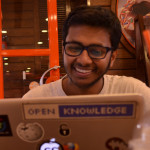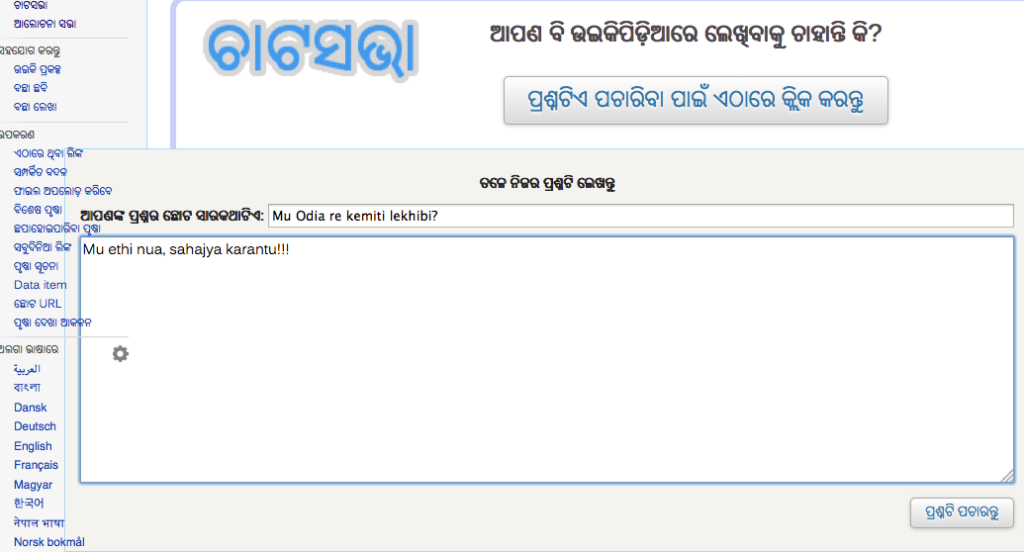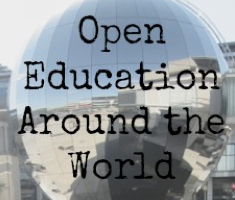Indic language Wikipedias as Open Educational Resources
The Open Education Working Group sees supporting multilingual activities such as translation to and from languages which are not often used as one of its key future roles. Subhashish Panigrahi’s post while dwelling upon the growth of Indic Wikimedia communities critically examines Wikipedia as an educational resource.
 Subhashish Panigrahi is an an educator and open source activist based in Bangalore, India. He is a long time Wikimedian and is involved in many activism and policy level debates around open education. Currently he is working at the Centre for Internet and Society’s Access To Knowledge program where he is working on designing implementation projects for catalyzing growth of Indic Wikimedia communities and content acquisition.
Subhashish Panigrahi is an an educator and open source activist based in Bangalore, India. He is a long time Wikimedian and is involved in many activism and policy level debates around open education. Currently he is working at the Centre for Internet and Society’s Access To Knowledge program where he is working on designing implementation projects for catalyzing growth of Indic Wikimedia communities and content acquisition.
In the past, he has worked on building partnership with universities, language research organizations, government departments, GLAM institutions and individuals for bringing more scholarly and encyclopedic content on language, culture and history under free licenses. He is excited about experimenting on new methodologies in education, building interactive educational resources and bringing knowledge producing institutions, resourceful experts and scholars under one roof. He has been involved in various language related conferences and spoken in both policy and implementation discourses around open knowledge and open source.
****
Since the inception of four Indic language Wikipedias: Assamese, Malayalam, Odia and Punjab in 2002, the focus of Wikimedia Foundation has been diverse in many aspects.
Wikipedia’s focus oriented from Latin to non-Latin projects which was high-risk but revolutionary specifically in four of the aforementioned languages besides the other language Wikipedias that came a little later. It is quite obvious that the number of contributors to the Indic language Wikimedia projects were very few. Indic input in Unicode standard was less popular. Wikipedia struggled back then and still continues to struggle in terms of getting voluntary contributions and quality content because of these reasons.
In its initial phase of community building the language projects faced difficulties in teaching people about typing in their own scripts. It was a painful exercise – starting from scratch to building language input tools and tutorials, conducting outreach for mass-awareness and educating them of the importance of building content for their future generation and other such activities. Today, about 12 out of the 20 Indic language Wikipedias are active in terms of growth in the size of the contributor community and quality content. However, since the available resources are more or less limited in general and also lacking more in regional languages, there has been dependence on text books as useful educational resources. There is a complete dearth of peer reviewed journals and research documents in Indic languages. If there are some, they have not been digitized and some of the digitized resources are not available in accessible formats. With this there is a need to rethink about the potential to open Wikipedia up for more contribution from the academia and researcher communities.
Conventionally educational resources are created by subject experts in a limited time frame and reviewed for factual accuracy. Wikipedia, on the contrary could be edited by anyone at any point of time and the content is ever changing. Many-a-times stub class articles get created. Not all of the articles are also of good quality. All of these result in a mixed spectrum of articles of varied quality. So, the entire Wikipedia, per se cannot be taken as OER.. It is quite challenging to get dedicated volunteers to devote their time to enhance the quality and keep the articles updated.
The ever changing nature of Wikipedia could be a potential opportunity to look at it as an educational resource that is more dynamic and upgradable in nature. Some of the subjects such as science or humanities in our education syllabi have content that is perpetually true in nature. If well written, then these kind of articles could be taken as OER as these do not need constant change. However, many other study programs including the applied disciplines are not up to date because of the conventional mode of education. There is a need to revamp the educational system and bring a more dynamic and informative system. Wikipedia, for sure will be a good platform for specific areas of education like these. However, this could be attained only if there are a group of contributors while implementing mass-scale WikipediaEducation Programs.
While working with two different batches of masters students of journalism at Indian Institute of MassCommunication at Dhenkanal in Odisha, I experienced the multitude of such fast pace of information flow that does not exist in many other disciplines. In general, people working on current issues of the world remain in a high information zone. If such talents could be tapped by bringing Wikipedia into their zone of action, then something great could be leveraged. Similarly, many researchers and people that are involved in work related documentation could be tapped when looking at specific subject areas for creating a subset of educational resource building exercise from Wikipedia.
The drawback in the existing text book compilation process is that a fixed number of people might make it a monotonous process. Things like visual appeal and user experience, the layers of reuse, remix and reproduction that Wikipedia offers will be lacking. The process of bringing Indic language Wikipedias into the curricula also unleashes the opportunity of creating an inclusive community of experts and passively absorbing information from the existing resources including books that are currently the only educational resources. The constant discourse that a language or academic community that are subsets of a Wikipedia community, cross-pollination of ideas, information, experiments from inter-related and interdisciplinary collectives adds many additional layers of complexity to the way information get on to Wikipedia. This very complexity makes it stand out as a completely different system altogether that learns, changes the ways of approach, preserves learning and presents itself is an institution.
So far, most of the Indic languages Wikipedias are the largest reservoirs of knowledge despite the challenges of sustaining the contributing community. To take them to a new level needs the risk of allowing potential vandals of taking it to the larger audience as a contributor and taking to the knowledge seeking mass as an Open Educational Resource. As Wikipedia itself, this would be another happening journey if the challenges and mistakes are accepted. Otherwise, bringing the right balance and opening up the existing system might just take centuries and that is alarming for this society that cannot wait inside the cocoon of being completely perfect but outdated and afford to walk slower.
 Open Education Working Group
Open Education Working Group 
![Odia Wikipedia workshop, IIMC, Dhenkanal 18-19 November 2013 [Source Wikmedia]](../files/2014/05/800px-Odia_Wikipedia_workshop_IIMC_Dhenkanal_18-19_November_2013_01.jpg)





[…] from the blog published on Open Education Working […]